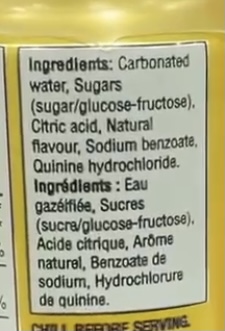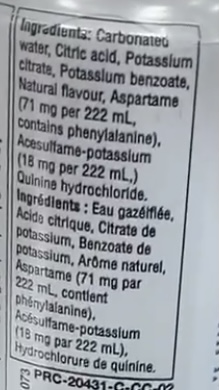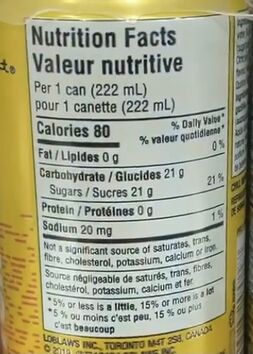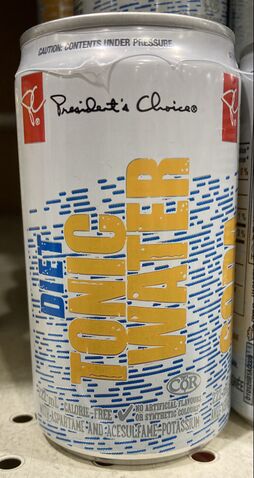Course:FNH200/Assignments/2021/President'sChoice TonicWater
Brief Introduction
Tonic water is a common ingredient in many drinks and cocktails[1]. Its sweet taste along with its fizzy mouth feel is used to enhance drinks such as gin and tonics. As the consumption of sugary soft drinks is trending downward[2], President's Choice also sells a version of the tonic water made with Aspartame and Acesulfame-Potassium.
Ingredient Lists
| Ingredient List | Regular Tonic Water | Diet Tonic Water |
|---|---|---|
| Carbonated Water | ✓ | ✓ |
| Glucose-fructose | ✓ | |
| Citric Acid | ✓ | ✓ |
| Natural Flavour | ✓ | ✓ |
| Sodium Benzoate | ✓ | |
| Quinine Hydrochloride | ✓ | ✓ |
| Potassium Citrate | ✓ | |
| Potassium Benzoate | ✓ | |
| Aspartame | ✓ | |
| Acesulfame-potassium | ✓ |


1. Sugar substitutes:
Aspartame:
- Aspartame, a blend of the amino acid aspartic acid and about 200 times sweeter than table sugar as a form of phenylalanine. Aspartame is heat-unstable. It is commonly used in beverages, breath mints, chewing gum, cocoa mixes, frozen desserts, gelatins, puddings, powdered soft drinks, or can be used as a tabletop sweetener. Aspartame is a choice of many people with diabetes and obesity. Although there are a lot of controversies regarding the safety of Aspartame, according to the affirmation of Food and Drug Administration (FDA), it is safe to consume, except for those with the genetic disorder of the metabolism called phenylketonuria[3].
- Role: Aspartame is known as a low calorie sweetener that mimics regular sugar. Thus, it can allow consumers to have a great tasting with less sugar and fewer calories because it needs only a small amount of Aspartame to sweeten foods and drinks[3].
Acesulfame-potassium (acesulfame-K):
- Acesulfame-K is known as a potassium salt that is around 200 times sweeter than sucrose. Unlike Aspartame, Acesulfame-K is stable at high temperatures so its storage is more flexible. It is also soluble in water. Acesulfame-K is used in baked goods, candies, chewing gum, desserts, diet drinks, gelatins, puddings. It is approved by FDA as well, however; there is evidence of Acesulfame-K risks[3].
- Role: This calorie-free sweetener is often combine with other sweeteners such as aspartame to stimulate sweet-taste on your tongue because when trying Acesulfame-K itself, it leaves a slightly bitter aftertaste[3].
2. Additives:
Potassium citrate:
- Potassium citrate acts as a pH buffer and thus preservative. It also makes an impact on the taste of foods and soft drinks. It helps to mask the acidic taste of soda thanks to its sour characteristic. It is generally recognized to be safe for use[4].
- Role: The sour characteristic provides a more balanced tart flavour. This is specially important in diet sodas because their sugar replacements themselves often have a less enjoyable flavour[4].
Potassium benzoate (E212):
- Potassium benzoate is obtained by the combination of benzoic acid and potassium salt under heat. It can be found in soda, flavoured drinks, fruit and vegetable juices, candy, chocolate, processed sauces, salad dressings, jams, salted or dried fish and seafood[5].
- Role: Potassium benzoate has an ability to prevent the growth of bacteria, yeast, and mold[5]. Thus, it is a well-known safe preservative to increase shelf life of various packaged foods.
High Fructose corn syrup (HFCS) (commonly labeled as “glucose-fructose”):
- Most sweet food items contain HFCS because it is extremely cheap, easy to transport, and easy to combine with other ingredients. Both sugar and HFCS are made out of glucose and fructose. Chemically speaking, Sucrose is a glucose molecule and fructose molecule bonded together, while HFCS is a mixture of glucose and fructose molecules without them being bound together. HFCS starts off as regular corn syrup and is further treated with enzymes derived from bacteria to convert much of the glucose into fructose, as fructose tastes much sweeter than glucose. HFCS is 42 to 55 percent fructose and the remaining percent comes from glucose and other sugars [6]. The most commonly used HFCS in soft drinks is 55 percent fructose and 45 percent glucose (HFCS- 55)[6]. The other two types are HFCS 42 and 90.
- Role: HFCS adds sweetness to drinks and food, and is equal to sweetness in table sugar. HFCS helps to increase freshness in food, lower freezing temperature points, keep moisture in cereals and energy bars, amplify fruit and spice flavours, nourish surface browning, and has fermentation properties. HFCS is primarily used in tonic water to improve taste and sweetness.
Citric Acid:
- Citric acid is naturally concentrated in many fruits and vegetables, with the primary fruits being lemons and limes. Citric acid is a weak acid with a pH level between 3 and 6. A common misconception for consumers is that the citric acid listed on the ingredients list comes from natural sources, however, the production of citric acid comes from microbial processes using Aspergillus niger [7] .The chemical formula for natural citric acid and manufactured citric acid is the same, C6H8O7.
- Role: Citric acid may be used to flavour, preserve, control pH, or used as an acidulant in food and beverages. Citric acid is used in tonic water as a preservative to maintain freshness and enhance the sour/acidic taste.
Sodium Benzoate:
- Sodium benzoate is a salt made out of benzoic acid and sodium hydroxide. It has an E number of E211. The substance is used as a preservative in acidic foods and beverages like cold drinks, sodas, jams, pickles, etc. There is much debate and controversy upon mixing citric acid with sodium benzoate. Some studies suggest that mixing the two ingredients and consuming them can lead to the formation of the harmful chemical benzene[8]. However, there are no confirmative answers on this debate and sodium benzoate is safe for use under Canadian food and drug regulations [9]. Sodium Benzoate is primarily used in acidic food and beverages with a pH of 4.0-4.5. The substance works best with a decreasing pH.
- Role: Sodium benzoate is a heavily used preservative in soft drinks to increase shelf-life and acidity flavour. It’s other major uses in food include preventing bacteria/spoilage/molds, maintaining freshness by slowing changes in flavour/colour, enhancing flavour, and controlling pH. Tonic water uses Sodium benzoate as a preservative, and this drink in particular contains 20 mg of sodium.
Quinine Hydrochloride:
- Quinine is mainly used in tonic water to give it a bitter taste.. Quinine is an alkaloid that comes from the bark of the cinchona tree and it was used as an anti-malaria drug from as early as the 1600s. The concentration of Quinine in tonic water is significantly lower than the amount found in modern anti-malaria drugs. According to the FDA, Quinine is deemed safe for use in food and may not exceed 83 parts per million in carbonated beverages [10].
- Role: Quinine Hydrochloride is primarily used as a flavouring agent for a bitter taste in foods and soft drinks (like tonic water and bitter lemon drinks).
Similarities & Differences
These products have a very similar ingredient list, both containing additives. The main difference is concerning the sweetener. While the regular product contains no sugar or fat substitutes, the diet product contains sugar substitutes (Aspartame and Acesulfame-Potassium).
Labels



Tonic Water Label
Using the Government of Canada’s Food Labelling Requirements Checklist[11], we can determine:
Common Name
- It has an appropriate common name present (tonic water) on the principal display panel and it is in a font that is larger than 1.6mm.
Net Quantity Declaration
- The net quantity (222 mL) is declared on the principal display panel, in metric units, and using the correct shorthand for millilitres.
- The appropriate units are used, and they are rounded to the correct number of figures (i.e. three).
- The font is in the correct size, and is bolded.
List of Ingredients and Allergen Labelling
- A list of ingredients is present, with the ingredients in order of descending proportions.
- All ingredients are listed using common names (with the exception of chemical preservatives that are known by their chemical names).
- The type of sugar used is listed under the “sugars” section of the ingredient list.
- As no common allergens are used in this product, none are required to be labelled.
- The list is the same in English and French.
Location
- The information from the ingredients list is presented on one of the sides of the cans, as a continuous list with no interruptions.
Presentation
- The print is in black and the background is in white in areas where ingredients and other important information is listed.
- All of the font and formatting rules are followed, and the text is easy to read.
Name and Principal Place of Business
- The principal place of business (Loblaw’s Inc.) is listed, and easily read, under the nutrition facts section.
Imported Product
- The product is made in Canada, and therefore does not need to list any importation details.
Date Markings
- There is no best before date listed (or alluded to) on the principal display panel, as this drink has a shelf life of longer than 90 days.
"Packaged On" Date
- There is no packaged on date listed (or alluded to) on the principal display panel, as this drink has a shelf life of longer than 90 days.
Storage Instructions
- There are no storage instructions for this drink as the only suggestion is to chill the drink before serving.
Expiration Date
- Expiration dates are not required, as this drink is not for special dietary use.
Legibility and Availability
- All of the above information is easily read and legible.
Nutrition Labelling
- A nutritional facts table is present on the principal display panel, will not be destroyed when the drink is opened, is on one continuous surface, and the product does not and will not block the table.
- It is presented in an appropriate fashion.
Contents
- The serving size is aligned with the regulated reference amount, and nothing exceeds 200% of the recommended daily intake.
- The calories are listed and four key nutrients are listed, as this is a small, single-serve container.
- There are no non-permitted nutrients in this drink.
- Metric amounts and percentages (of daily value) of the listed nutrients are easily readable.
Graphical and Technical Requirements
- Everything is easily readable, with the correct formatting.
Bilingual Requirements
- All of the required bilingual text (English and French) is available.
Irradiation
- This drink does not have the permissible irradiation symbol on the container.
Sweeteners
- Since the sweetener used is sugar (glucose-fructose), it is listed in the ingredients list. Its proportion is listed in terms of grams and percentage of daily recommended intake. Aspartame is not used in this drink.
Country of Origin
- This product was produced in Canada.



Diet Tonic Water Label
Using the Government of Canada’s Food Labelling Requirements Checklist[11], we can determine:
Common Name
- The product has an appropriate common name present (Diet Tonic Water) on the principal display panel. The common name is also in letters greater than 1.6 mm.
Net Quantity Declaration
- This product has a net quantity of 222 mL declared on the principal display panel (PDP).
- It is presented in metric units, makes use of the correct bilingual symbols for milliliter's (mL) and uses the appropriate units which are rounded to the correct number of figures (i.e. three).
- The size of the numerical portion also meets the requirements on the PDP and is bolded.
List of Ingredients and Allergen Labelling
- A list of ingredients is present, with the ingredients in order of descending proportions by weight.
- All ingredients are listed using common names (with the exception of chemical preservatives that are known by their chemical names).
- Since there are no common allergens used in this product, they are not required to be labelled.
- The English and French lists of ingredients are the same.
Location
- The information about the ingredients list is present on one of the sides of the cans, as a continuous list with no interruptions.
Presentation
- The print is in black and the background of the cans and the ingredients list is in white. There is a contrast between the colours, all the font and formatting rules are followed, and the text is easy to read. The characters also appear in upper case and lower case as required.
Name and Principal Place of Business
- The principal place of business (Loblaw’s Inc.) is listed, and easily read, under the nutrition facts section.
Imported Product
- The product is manufactured in Canada, and therefore does not need to list any importation details.
Date Markings
- There is no best before date listed (or alluded to) on the principal display panel, as this drink has a shelf life of longer than 90 days.
"Packaged On" Date
- There is no packaged on date listed (or alluded to) on the principal display panel, as this drink has a shelf life of longer than 90 days.
Storage Instructions
- There are no storage instructions for this drink and the only suggestion is to chill the drink before serving it.
Expiration Dates
- Expiration dates are not required, as this drink is not for special dietary use.
Legibility and Availability
- All of the above information is legible and readily discernible.
Nutrition Labelling
- There is a nutritional facts table (NFt) present on the principal display panel (PDP).
- It will not be destroyed when the can is opened, is present on one continuous surface and is placed in a way in which the product does not and will not block the table.
- The appropriate format family is also used.
Contents
- The serving size is aligned with the regulated reference amount, and nothing exceeds 200% of the recommended daily intake.
- There are no non-permitted nutrients in this drink.
- Metric amounts and percentages (of daily value) of the listed nutrients are easily readable.
Graphical and Technical Requirements
- The contents table background and print is in the appropriate colors, everything is easily readable, with the correct formatting. The information is also in the correct order.
Bilingual Requirements
- All of the mandatory information is in English and French, meeting the bilingual text requirements.
Irradiation
- This drink does not have the permissible irradiation symbol on the container.
Sweeteners
- Aspartame is used in this product and there is a phenylalanine declaration in the ingredients table.
- The product also contains Acesulfame-potassium.
Country of Origin
- This product was produced in Canada.
References
- ↑ Chan, S. A., & Shim, T. N. (2018). Image Gallery: Gin, tonic water and the sun. British Journal of Dermatology, 177(6). https://doi.org/10.1111/bjd.15891
- ↑ Government of Canada, Statistics Canada. (2021, May 31). Food available in Canada. Government of Canada, Statistics Canada. https://www150.statcan.gc.ca/t1/tbl1/en/tv.action?pid=3210005401&pickMembers%5B0%5D=1.1&pickMembers%5B1%5D=3.28&cubeTimeFrame.startYear=2016&cubeTimeFrame.endYear=2020&referencePeriods=20160101%2C20200101.
- ↑ 3.0 3.1 3.2 3.3 Marcus, J. B. (2013). Chapter 4 - Carbohydrate Basics: Sugars, Starches and Fibers in Foods and Health: Healthy Carbohydrate Choices, Roles and Applications in Nutrition, Food Science and the Culinary Arts. Science Direct. https://www.sciencedirect.com/science/article/pii/B9780123918826000042.
- ↑ 4.0 4.1 Sturm, J. (2019, November 5). Potassium Citrate, Keeping Your Food Fresh for Longer. Vynona. https://www.vynova-group.com/blog/potassium-citrate-keeping-food-fresh.
- ↑ 5.0 5.1 Petre, A. (2020, September 22). What Is Potassium Benzoate? Uses, Foods, and Side Effects. Healthline. https://www.healthline.com/nutrition/potassium-benzoate.
- ↑ 6.0 6.1 Marcus, J. B. (2013, November 6). Fluid Basics: Healthfully Meeting Fluid Needs: Healthy Fluid Choices, Roles and Applications. Culinary Nutrition. https://www.sciencedirect.com/science/article/pii/B978012391882600008X.
- ↑ Sweis, I. E., & Cressey, B. C. (2018, August 9). Potential role of the common food additive manufactured citric acid in eliciting significant inflammatory reactions contributing to serious disease states: A series of four case reports. Toxicology reports. https://www.ncbi.nlm.nih.gov/pmc/articles/PMC6097542/.
- ↑ Salviano Dos Santos, V. P., Medeiros Salgado, A., Guedes Torres, A., & Signori Pereira, K. (2015). Benzene as a Chemical Hazard in Processed Foods. International journal of food science. https://www.ncbi.nlm.nih.gov/pmc/articles/PMC4745501/
- ↑ Branch, L. S. (2021, July 12). Consolidated federal laws of canada, Food and Drug Regulations. Food and Drug Regulations. https://laws-lois.justice.gc.ca/eng/regulations/C.R.C.,_c._870/page-74.html#h-573289.
- ↑ CFR - Code of Federal Regulations Title 21. accessdata.fda.gov. (n.d.). https://www.accessdata.fda.gov/scripts/cdrh/cfdocs/cfcfr/CFRSearch.cfm?fr=172.575.
- ↑ 11.0 11.1 Government of Canada, C. F. I. A. (2019, January 15). Government of Canada. Canadian Food Inspection Agency. https://inspection.canada.ca/food-label-requirements/labelling/industry/food-labelling-requirements-checklist/eng/1393275252175/1393275314581.
| This Food Science resource was created by Course:FNH200. |
